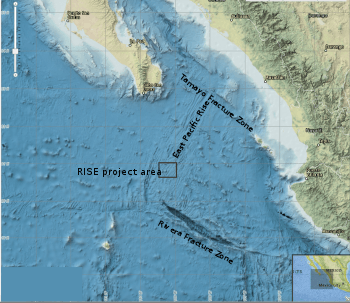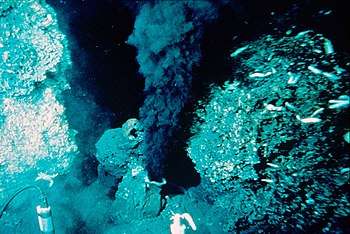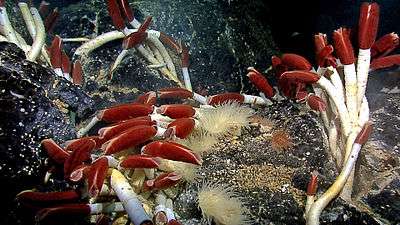RISE project
The RISE Project (Rivera Submersible Experiments) was a 1979 international marine research project which mapped and investigated seafloor spreading in the Pacific Ocean, at the crest of the East Pacific Rise (EPR) at 21° north latitude. Using a deep sea submersible (ALVIN) to search for hydrothermal activity at depths around 2600 meters, the project discovered a series of vents emitting dark mineral particles at extremely high temperatures which gave rise to the popular name, "black smokers".[1] Biologic communities found at 21° N vents, based on chemosynthesis and similar to those found at the Galapagos spreading center,[2] established that these communities are not unique. Discovery of a deep-sea ecosystem not based on sunlight spurred theories of the origin of life on Earth.[3]

Location
The RISE expedition took place on the East Pacific Rise spreading center at depths around 2,600 meters (8,500 ft), at 21° north latitude about 200 kilometers (110 nautical miles) south of Baja California, and 350 kilometers (190 nautical miles) southwest of Mazatlán, Mexico.[1] The study area at 21° N was selected following results from a series of detailed near-bottom geophysical surveys that were designed to map the geologic features associated with a known spreading center.[4][5]
Experiments
The project objective was detecting and mapping the sub-seafloor magma chamber that feeds lavas and igneous intrusions that create the oceanic crust and lithosphere in the process of seafloor spreading. The approach comprised many geophysical techniques including seismology,[1] magnetism,[6] crustal electrical properties,[7] and gravity.[8] The major experiment effort though, was seafloor observation and sample collection using the deep submergence submersible ALVIN on the crest of the EPR at depths of 2600 meters or more.[1]
RISE was part of the RITA (Rivera-Tamayo expeditions) project, which included submersible investigations (CYAMEX) at 21° N and at the Tamayo Fracture zone at the mouth of the Gulf of California.[9] The RITA project used the French submersible CYANA on the CYAMEX expeditions. CYANA dives at 21° N occurred in 1978, one year prior to the RISE expedition.[9]
Participants
American, French, and Mexican biologists, geologists, and geophysicists participated in both the RISE and RITA expeditions. The RISE expedition was directed by scientists at the Scripps Institution of Oceanography, part of the University of California, San Diego. Project leaders were Fred Spiess and Ken Macdonald. Woods Hole Oceanographic Institution provided the ALVIN and its support tender the catamaran Lulu. Scripps provided surface survey vessels the Melville and New Horizon. The expedition took place during March to May 1979. The RITA Project was directed by French scientists and was led by Jean Francheteau.[9]
Findings

The major finding of the RISE project was discovery of very hot hydrothermal fluids emanating from the sea floor from vents at separate locations along the crest of the rise.[1] These were anticipated by the discovery during the CYAMEX expedition a year earlier of massive sulfide mineral deposits on the sea floor at 21°N, which were presumed to be due to hydrothermal activity, but which was not then observed.[10][11] During RISE dives, the hot vents were found and were marked by mineralized chimneys, about a half-meter in diameter and one to a few meters high, composed of sulfide minerals of zinc, copper and iron.[12] Emitting from the chimneys were black plumes or jets of fine particles of these minerals, giving rise to the popular name “black smokers".[1] Temperatures measured of these jets were 38030° Celsius.[1] Several vents of lower temperature emissions were found (<23°C). These warm vents were similar to those discovered at the Galapagos Spreading Center a few years earlier.[2] Hot vents and black smokers were not found at the Galapagos. Modeling of gravity data measured on the seafloor suggested that much of the upper ocean crust at 21°N was fractured and filled with warm water.[8]
Scientific impact

Massive sulfide deposits have been mined on land in places including Cyprus, Oman and Australia.[13] The discovery of massive sulfide deposits associated with vent fields at spreading centers provided a model for how these deposits formed.[10][11] It also spurred commercial efforts to mine these deep sea deposits found elsewhere.[14]
Marine geologists were puzzled for years by conductive heat flow data from the seafloor that showed the measured values at spreading centers were too low for theoretical models of seafloor spreading.[15] The convective crustal heat transfer computed for the first time from the vent plumes was estimated to be many-fold the observed conductive heat flow at a spreading center.[16] These observations pointed to the importance of convective heat flow at spreading centers and provided an answer to the low heat flow problem.[15]
The discovery of biological communities at low temperature warm vents at 21°N, populated by a benthic community the same or similar to that discovered at the Galapagos Spreading center,[2] established that life forms found at the Galapagos were not unique. Further, the significance of discovering at the Galapagos site and 21°N of a chemosynthetic ecosystem that was not dependent on sunlight, existed at high pressures, and was based on chemicals emitted via volcanism, provided a model for how life could have originated on Earth.[3][17]
See also
References
- Spiess, F. N.; Macdonald, K. C.; Atwater, T.; Ballard, R.; Carranza, A.; Cordoba, D.; Cox, C.; Garcia, V. M. D.; Francheteau, J. (1980-03-28). and RISE team. "East Pacific Rise: Hot Springs and Geophysical Experiments". Science. 207 (4438): 1421–1433. Bibcode:1980Sci...207.1421S. doi:10.1126/science.207.4438.1421. ISSN 0036-8075. PMID 17779602.
- Corliss, John B.; Dymond, Jack; Gordon, Louis I.; Edmond, John M.; von Herzen, Richard P.; Ballard, Robert D.; Green, Kenneth; Williams, David; Bainbridge, Arnold (1979-03-16). "Submarine Thermal Springs on the Galápagos Rift". Science. 203 (4385): 1073–1083. Bibcode:1979Sci...203.1073C. doi:10.1126/science.203.4385.1073. ISSN 0036-8075. PMID 17776033.
- Martin, William; Baross, John; Kelley, Deborah; Russell, Michael J. (2008). "Hydrothermal vents and the origin of life". Nature Reviews Microbiology. 6 (11): 805–814. doi:10.1038/nrmicro1991. ISSN 1740-1526. PMID 18820700.
- Larson, R. L.; Spiess, F. N. (1969-01-03). "East Pacific Rise Crest: A Near-Bottom Geophysical Profile". Science. 163 (3862): 68–71. Bibcode:1969Sci...163...68L. doi:10.1126/science.163.3862.68. ISSN 0036-8075. PMID 17780175.
- Normark, William R. (1976). "Delineation of the main extrusion zone of the East Pacific Rise at lat 21°N". Geology. 4 (11): 681. Bibcode:1976Geo.....4..681N. doi:10.1130/0091-7613(1976)4<681:DOTMEZ>2.0.CO;2. ISSN 0091-7613.
- Macdonald, Ken C.; Miller, Stephen P.; Luyendyk, Bruce P.; Atwater, Tanya M.; Shure, Loren (1983). "Investigation of a Vine-Matthews Magnetic Lineation from a submersible: The source and character of marine magnetic anomalies". Journal of Geophysical Research: Solid Earth. 88 (B4): 3403–3418. Bibcode:1983JGR....88.3403M. doi:10.1029/JB088iB04p03403. ISSN 2156-2202.
- Young, Peter D.; Cox, Charles S. (1981). "Electromagnetic active source sounding near the East Pacific Rise". Geophysical Research Letters. 8 (10): 1043–1046. Bibcode:1981GeoRL...8.1043Y. doi:10.1029/GL008i010p01043. ISSN 1944-8007.
- Luyendyk, Bruce P. (1984). "On‐bottom gravity profile across the East Pacific Rise crest at 21° north". Geophysics. 49 (12): 2166–2177. Bibcode:1984Geop...49.2166L. doi:10.1190/1.1441632.
- Cyamex Scientific Team; Francheteau, J.; Needham, H. D.; Choukroune, P.; Juteau, T.; Seguret, M.; Ballard, R. D.; Fox, P. J.; Normark, W. R. (1981). "First manned submersible dives on the East Pacific Rise at 21°N (project RITA): General results". Marine Geophysical Researches. 4 (4): 345–379. Bibcode:1981MarGR...4..345F. doi:10.1007/BF00286034. ISSN 0025-3235.
- Francheteau, J.; Needham, H. D.; Choukroune, P.; Juteau, T.; Séguret, M.; Ballard, R. D.; Fox, P. J.; Normark, W.; Carranza, A. (1979). "Massive deep-sea sulphide ore deposits discovered on the East Pacific Rise" (PDF). Nature. 277 (5697): 523–528. Bibcode:1979Natur.277..523F. doi:10.1038/277523a0. ISSN 0028-0836.
- Hekinian, R.; Fevrier, M.; Bischoff, J. L.; Picot, P.; Shanks, W. C. (1980-03-28). "Sulfide Deposits from the East Pacific Rise Near 21 N". Science. 207 (4438): 1433–1444. doi:10.1126/science.207.4438.1433. ISSN 0036-8075. PMID 17779603.
- Haymon, Rachel M.; Kastner, Miriam (1981). "Hot spring deposits on the East Pacific Rise at 21°N: preliminary description of mineralogy and genesis". Earth and Planetary Science Letters. 53 (3): 363–381. Bibcode:1981E&PSL..53..363H. doi:10.1016/0012-821X(81)90041-8.
- Perkins, W. G. (1984-07-01). "Mount Isa silica dolomite and copper orebodies; the result of a syntectonic hydrothermal alteration system". Economic Geology. 79 (4): 601–637. doi:10.2113/gsecongeo.79.4.601. ISSN 1554-0774.
- Miller, Kathryn A.; Thompson, Kirsten F.; Johnston, Paul; Santillo, David (2018). "An Overview of Seabed Mining Including the Current State of Development, Environmental Impacts, and Knowledge Gaps". Frontiers in Marine Science. 4. doi:10.3389/fmars.2017.00418. ISSN 2296-7745.
- Lister, C. R. B. (1972). "On the Thermal Balance of a Mid-Ocean Ridge". Geophysical Journal International. 26 (5): 515–535. Bibcode:1972GeoJ...26..515L. doi:10.1111/j.1365-246X.1972.tb05766.x. ISSN 0956-540X.
- Macdonald, Ken C.; Becker, Keir; Spiess, F.N.; Ballard, R.D. (1980). "Hydrothermal heat flux of the "black smoker" vents on the East Pacific Rise". Earth and Planetary Science Letters. 48 (1): 1–7. Bibcode:1980E&PSL..48....1M. doi:10.1016/0012-821X(80)90163-6.
- Chemistry of seabed’s hot vents could explain emergence of life. Astrobiology Magazine 27 April 2015.
Further reading
- Ballard, R.D.; Grassle, J.F. (1979). "Incredible world of deep sea rifts". National Geographic. 156: 680–705.
- Ballard, Robert D. (2017-03-21). The eternal darkness : a personal history of deep-sea exploration. Hively, Will (New Princeton Science Library ed.). Princeton, N.J. ISBN 9780691175621. OCLC 982214518.
- Crane, Kathleen. (2003). Sea legs : tales of a woman oceanographer. Boulder, Colo.: Westview Press. ISBN 978-0813340043. OCLC 51553643.
- Haymon, R.M. (2014), "Hydrothermal Vents at Mid-Ocean Ridges", Reference Module in Earth Systems and Environmental Sciences, Elsevier, doi:10.1016/b978-0-12-409548-9.09050-3, ISBN 9780124095489, retrieved 2019-06-27
- Macdonald, Ken C.; Luyendyk, Bruce P. (1981). "The Crest of the East Pacific Rise". Scientific American. 244 (5): 100–117. Bibcode:1981SciAm.244e.100M. doi:10.1038/scientificamerican0581-100. ISSN 0036-8733. JSTOR 24964420.
- Van Dover, Cindy. (2000). The ecology of deep-sea hydrothermal vents. Princeton, N.J.: Princeton University Press. ISBN 978-0691057804. OCLC 41548235.